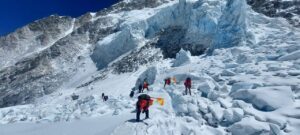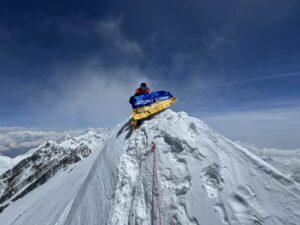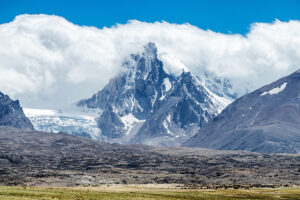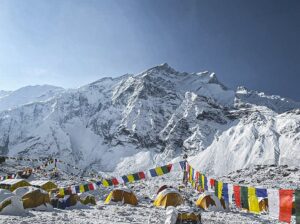Little by little, what happened during Broad Peak’s recent summit push is becoming clearer. The home team of Russian Vitaly Lazo of the Deathzone Freeride (DZF) team has posted a complete report detailing attempts to rescue Korean climber Kim HongBin.
Likewise, Oswald Rodrigo Pereira of Poland — who summited Broad Peak without oxygen — has explained Anastasia (Nastya) Runova’s accident. Pereira and Austrian guide Stefan Keck led her subsequent rescue.
Pereira says that he was hesitant to speak about the issue but “as a reporter, I think it is important to clarify and help to understand the truth,” he said.
Death Zone Freeride: Rescue Timeline
July 17
At 11 pm local time, the DZF team began their climb to the summit from Camp 3 (7,100m), along with five other teams. Good weather was forecast for the next two days, and everyone was in a hurry.
July 18
At 4:30 pm, Anton Pugovkin, Vitaly Lazo, and Thomas Lone decided to turn back. It was still an hour and a half to the top, and if they continued, they would have to go down in the dark. They decided not to risk it.

Broad Peak on July 18, the summit day. Photo: Mirza Ali
At 8 pm, the DZF team descended to Camp 3. (They have decided to go back up for a second attempt in a few days, in better weather.) At the same time, several groups continued their ascent, including a Korean team and a group with a young climber from Russia, Anastasia Runova.
At midnight, the DZF team received a message: In the col area at 7,900m, a girl had fallen. There was also some sort of emergency involving Kim HongBin.
July 19
At 12:15 am, Pugovkin and Lazo went to the rescue, while climbers in Camp 3 gathered additional medicine and oxygen.
Reportedly, a porter helped Anastasia back up and they began to descend. She went down without her crampons, which had come off during the mishap.
At 4 am, Anton Pugovkin and Vitaly Lazo met Anastasia. They gave her an injection of dexamethasone and a drink, and Pugovkin began to help her down to Camp 3. Meanwhile, Lazo took a walkie-talkie and some oxygen and went to help Mr. Kim.
Anastasia and Pugovkin reached Camp 3. After resting, she was able to descend safely to Base Camp, with the help of other climbers.
At 1:30 pm, Pugovkin went up to join Lazo, who was trying to save Kim. Kim had fallen from an 80-degree wall. When Lazo reached Kim, at an altitude of 7,900m, several Pakistani porters and Korean climbers were already nearby.
Lazo rappeled 20m down and helped Kim set an anchor. Then the alpinists began to climb. But after some time, Kim’s jumar seemingly jammed. (Lazo was five metres below him.)
Lazo shouted to Kim. The Korean alpinist was moving, trying to unjam the jumar. Suddenly Kim fell.
“With 99% certainty, we can say that he died immediately,” said Lazo. “It was horrible.”
Lazo managed to climb back up and began to descend. At 5:20 pm, Pugovkin and Lazo rejoined and continued down to Base Camp, partly on skis, partly on foot. A blizzard now raged.
By 9:16 pm, they were in Base Camp. Thomas Lone arrived there a little earlier.
Oswald R. Pereira’s Statement: Events of July 18-19
Hugo, Niels, and I summited at 3:15 pm. We spent around 20 minutes on the summit and started our descent. On our way down, we met some fixing team members from Pakistan, as well as Nastya Runova and the Korean team.

The first (and no-O2) summiters of Broad Peak this season. Left to right, Oswald Rodrigo Pereira, Hugo Ayaviri, and Niels Jespers. Photo: O.R. Pereira
At 5:14 pm, I got a message via inReach from Nastya sent from 8,036m, asking me to wait for her. I waited at the col at an altitude of 7,850m. After around two hours, I heard Hussein (a Pakistani on the Korean team) screaming that a woman had fallen near the last section before the col. I left my backpack and ran up. Nastya had fallen through a snow cornice near the last section above the col.
I held the rope (later joined by Stefan [Keck] from Austria) that she was attached to for a couple of hours, while Hussein tried to help her. She finally got up to a safe place at around 10:00 pm.
Nastya was mentally okay but had mild frostbite on her hands. She lost one crampon and her jumar. We (Nastya, Stefan, and I) descended to the col, where I boiled some water. I had gas and Nastya had an MSR Reactor. It was 10:25 pm.

Broad Peak at night. Photo: Oswald Rodrigo Pereira
Stefan started his descent and we followed, first Nastya, then I. Shortly after we started, Nastya slipped on the ropes (she didn’t have one crampon) and lost her headlamp. I gave her my backup one. We descended at an incredibly slow pace until 7,650m.
At this point, Nastya slid down around 100m. During her fall, she passed the crevasse that we had to deal with two days before. Stefan and I went down as quickly as possible and found her lying down. She was in good condition but in shock. I boiled more water, Stefan confirmed that we were good, and we continued.
I went first, then Nastya was clipped to the rope with her carabiner and held my hand or arm so that I could stop her fall. We stopped every 10-15 steps so that she could catch her breath and also recover from the pain she was feeling.
For the last hour, I myself clipped in because I too slid down twice. On the way, we met Peter from the UK. He helped us with his presence and gave us some hot water and chocolate. His porter gave us his radio, and we talked to BC. We explained the situation and said that we would continue. Peter joined us for some time.

Anton Pugovkin and Nastya Runova. Photo: Deathzone Freeride
Our painful descent (we hadn’t eaten anything solid for 27 hours) continued until 5:00 am on July 19. A hundred metres above Camp 3, we met the Russians from the Death Zone Freeride Team. I spoke with Vitaly [Lazo] for a minute and continued. Anton [Pugovkin] helped Nastya down to Camp 3. I went directly to the tent and entered it at 5:10 am.
The next day, people from Belgium and Russia offered help. Nastya got medicine from the Death Zone Freeride Team. They also gave her one crampon. We started our descent at noon. Niels from Belgium and Hugo from Bolivia helped Nastya to C2. Niels carried her backpack. From C2, we continued our descent with visual contact until the glacier.
More: Pereira Speaks to ExWeb
ExplorersWeb has managed to exchange some text messages with Oswald Pereira over InReach, hoping to clear up some details. For example, what caused two people, Runova and Kim, to fall in the same place? As on K2, questions have also arisen about the state of the ropes, but Pereira dismissed that factor.
“On that particular section, there was actually a good, new rope,” Pereira said. “In my opinion, the problem was that the snow conditions on the [corniced] section changed through the day and might have caused Nastya’s fall. People descended mainly down the snowy part, instead of putting their crampons and body weight on the rocky sections. Kim descended exactly to the point where Nastya had fallen, and he rappelled down, [mistakenly] thinking the route went that way.” Check this previous story citing Israfil Ashurli, who suggested that the rocks were likely safer at that spot.

Niels Jespers or Pereira on steep, soft snow between the col and the summit of Broad Peak. Photo: Oswald Rodrigo Pereira
Pereira, Jespers, and Ayaviri were the first to reach the top. We asked whether, from what they saw, anyone else summited as well.
“After us, two, maybe three Pakistani porters reached the summit,” Pereira said. “Nastya was not far away, and she told us that she had summited. After her was the Korean team, but I do not know if they made it to the main summit or not.”
As for Stefan Keck, Pereira met him at the col on the way up and at 7,900m on the way down. “I didn’t see him any closer to the summit,” Pereira said.






